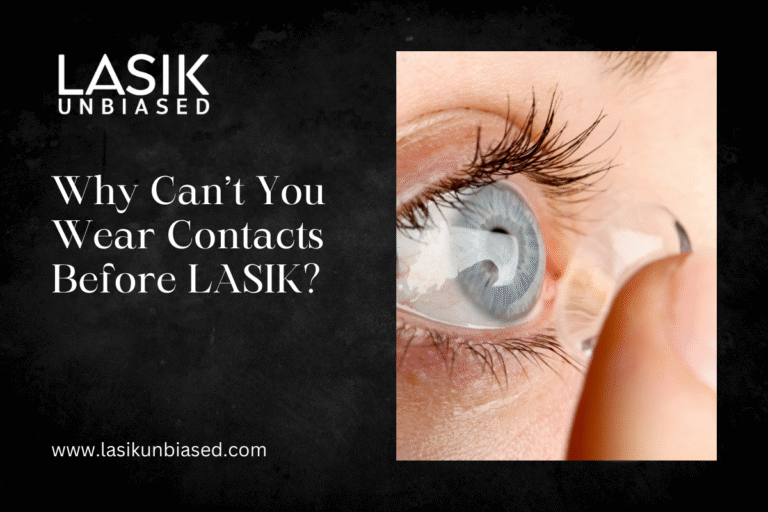You shouldn’t wear contact lenses before LASIK because they can change the shape of your cornea, affecting the accuracy of the pre-surgery measurements.
This step ensures optimal results and minimises potential complications during your LASIK procedure.
If you’re preparing for LASIK surgery, you might be wondering why wearing contact lenses is discouraged before the operation. While this recommendation can feel inconvenient, it’s a crucial measure that safeguards the precision of your treatment. Below, we’ll break down why this is necessary and how contact lenses can interfere with your LASIK outcomes.
The Role of Corneal Shape in LASIK Surgery
Corrective vision surgeries, such as LASIK, depend heavily on the shape of the cornea. The cornea is the transparent outer layer at the front of the eye that bends and focuses light onto the retina to create clear vision. A miscalibrated laser based on altered corneal data could lead to less effective results or require further corrections.
Contact lenses can temporarily mold the shape of your cornea due to prolonged wear, especially with rigid lenses. Therefore, coming to your LASIK consultation or surgery wearing contacts risks the accuracy of corneal measurements, leading to imprecise corrections.
How do Contacts Affect Corneal Shape?
Contact lenses sit directly on the surface of the eye and correct refractive errors by altering how light is focused onto the retina. Various types of lenses can have different impacts, such as:
- Rigid Gas Permeable lenses: These rest on the cornea and can temporarily alter its shape more significantly due to their firmness, often requiring several weeks of discontinuation before accurate LASIK measurements can be taken.
- Soft Lenses: These conform more closely to the cornea and have a milder effect, but they can still slightly distort corneal measurements and typically require about a week of discontinuation.
- Hybrid Lenses: With a rigid centre and soft skirt, these can affect the cornea similarly to RGP lenses and usually require a comparable break period before LASIK evaluation.
Wearing these lenses consistently can lead to subtle yet measurable alterations, leading medical professionals to insist on a time buffer before LASIK.
Accurate Corneal Measurements are Critical
During a LASIK consultation, your surgeon performs an elaborate set of diagnostic tests to map your cornea. This includes corneal topography, pachymetry (corneal thickness), and wavefront mapping to assess curvature, thickness, and optical irregularities.
If the cornea doesn’t appear in its natural state, any measurements taken will be unreliable. This can result in an inaccurate laser treatment plan, potentially compromising your post-surgery vision.
How Long Should You Avoid Contacts?
Here’s a general timeline for discontinuing contact lens use before your LASIK procedure, though this can vary by individual and the type of lenses used:
- Soft Lenses: Discontinue wearing these at least 5 to 7 days before your consultation and surgery, depending on how long and frequently you’ve used them.
- Rigid Gas Permeable (RGP) Lenses: Stop wearing these at least 3 to 4 weeks in advance, as they can significantly alter corneal shape.
- Hybrid Lenses: Similar to RGP lenses, these should be discontinued at least 2 to 4 weeks prior, depending on corneal stability assessed by your surgeon.
Your LASIK surgeon will provide tailored advice based on your eye health and the type of lenses you usually wear. It’s essential to follow these directives strictly to ensure the surgery goes as planned.
Risks of Wearing Contacts Before LASIK
Wearing contact lenses too close to your LASIK surgery date comes with potential risks. Here’s what could go wrong if you fail to comply with the no-contact lens rule:
1. Unreliable Results
The laser might reshape the cornea based on inaccurate readings, resulting in overcorrection or undercorrection. This could leave you requiring glasses or additional procedures to fix residual blurriness.
2. Corneal Health Issues
Contact lens use can contribute to dry eye symptoms or minor surface irritation, which may worsen post-LASIK discomfort. A dry or compromised corneal surface can reduce surgical accuracy and increase the risk of complications such as delayed healing or infection.
3. Prolonged Visual Recovery Times
Surgical outcomes may be less predictable, meaning longer healing times or visual fluctuations as the cornea stabilises post-procedure.
Strictly abstaining from contact lenses ahead of surgery ensures your corneas are in optimal condition, giving the surgeon a clear framework to deliver the best results.
LASIK and Contact Lenses: The Science Behind the Rule
Though it might feel unnecessarily cautious, the advice to avoid contact lenses is rooted in sound science. During LASIK:
- The surgeon reshapes the cornea using a highly precise excimer laser to correct visual impairments such as myopia, hyperopia, or astigmatism.
- Every fraction of a millimetre counts. Any deviation in corneal measurements could lead to suboptimal results.
- Surgeons use topographic imaging and pachymetry (corneal thickness) to assess surgical feasibility. Both depend on natural corneal conditions.
Wearing lenses, even intermittently, can disrupt the laser’s effectiveness and jeopardise the procedure’s precision.
Preparing for LASIK Consultation Without Contacts
Here are some tips to ensure a seamless process leading up to your LASIK consultation and surgery:
- Plan Ahead: Schedule your LASIK consultation well in advance and factor in the required “no contact” window.
- Switch to Glasses: Transition to glasses as soon as you begin considering LASIK to allow your corneas sufficient time to return to their natural shape before pre-surgical measurements.
- Hydrate Your Eyes: Use preservative-free artificial tears to keep your eyes moisturised, as avoiding lenses can sometimes make your eyes feel drier temporarily.
- Discuss Concerns with Your Surgeon: Be upfront about how often you wear contacts and the type of lenses you use. This information can guide the surgeon’s recommendations.
Commitment to Pre-Surgery Guidelines Ensures Post-Surgery Success
Avoiding contact lenses may seem like a minor inconvenience, but it’s a critical element of successful LASIK surgery. These seemingly small steps lay the foundation for precise, predictable outcomes, ensuring you achieve the clear vision you desire.
Remember, LASIK procedures offer life-changing results when approached with careful preparation. By adhering to your surgeon’s guidelines, you’ll maximise the benefits of your surgery and minimise any risks.
If you’re considering LASIK or have questions about preparing for your surgery, consult a qualified professional who can tailor recommendations to your needs.


